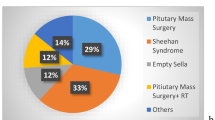Abstract
In patients with ACTH-secreting pituitary tumor the peri-tumoral normal corticotrophs were supposed to be suppressed by cronic hypercortisolemia since frequently they develop transient secondary adrenal insufficiency after pituitary tumor resection and during early postoperative days. We evaluated the ACTH dynamics during transsphenoidal surgery in 16 patients with ACTHsecreting pituitary tumors (6 cured by surgery, 8 not cured Cushing’s disease patients and 1 cured by surgery and 1 not cured Nelson’s syndrome patients) and tested the hypothesis that in these patients, ACTH secretion from the peri-tumoral normal corticotrophs is inhibited and hence removal of the entire tumor should result in subtle postoperative reduction in plasma ACTH. Blood samples for ACTH determination were obtained from 14 Cushing’s disease patients immediately before pituitary gland manipulation and 10, 30, 60, 90, 120, 150 and 300 min after pituitary tumor resection and on postoperative day one. In Nelson’s syndrome patients the blood sample was obtained only after tumor removal. All patients received intravenous hydrocortisone during surgery and on the first postoperative day. Patients were considered cured by surgery if they presented adrenal insufficiency after hydrocortisone withdrawal. Mechanical pituitary manipulation induced increase in ACTH level. In all 14 Cushing’s disease patients (cured and not cured), mean plasma ACTH levels were significantly greater 10 min after pituitary tumor resection (54.4±12.8 pmol/l) than in the premanipulation period (ACTH=26.3±5.3 pmol/l) (p=0.005). In Cushing’s disease patients, the ACTH levels did not change significantly until 300 min after pituitary tumor resection either in those 6 patients cured by surgery (at 10 min after pituitary tumor resection ACTH was 54.4±12.8 pmol/l for all 14 Cushing’s disease patients and at 300 min after tumor removal ACTH was 39.0±12.6 pmol/l for cured and 41.3±15.7 pmol/l for not cured Cushing’s disease patients). The ACTH level also persisted high until 300 min after complete pituitary tumor resection in one cured patient with Nelson’s syndrome. ACTH level does not change in the early recovery period after ACTH-secreting pituitary tumor, even in those cured patients, and probably peri-tumoral normal corticotrophs are not completely suppressed by cronic hypercortisolemia (and acute glucocorticoid administration) when these patients are under intense stress, like transsphenoidal surgery. Mechanical pituitary manipulation may induce ACTH release in patients with ACTH-secreting pituitary tumors but probably does not interfere in the maintenance of high ACTH-levels during the early postoperative period, since ACTH half-life is only 8–15 min. In patients with ACTH-secreting pituitary tumors, the behavior of the human hypothalamic-pituitary-adrenal system during transsphenoidal surgery does not conform to the specifications of a negative feedback mechanism.
Similar content being viewed by others
References
Udelsman R., Norton J.A., Jelenich S.E., Goldstein D.S., Linehan W.M., Loriaux D.L., Chrousos G.P. Responses of the hypothalamic-pituitary-adrenal and renin-angiotensin axes and the sympathetic system during controlled surgical and anesthetic stress. J. Clin. Endocrinol. Metab. 1987, 64: 986–994.
Arafah B.M., Kailani S.H., Nekl D.E., Gold R.S., Selman W.R. Immediate recovery of pituitary function after transsphenoidal resection of pituitary macroadenomas. J. Clin. Endocrinol. Metab. 1994, 79: 348–354.
Graham K.E., Samuels M.H., Faff H., Barnwell S.L., Cook D.M. Intraoperative adrenocorticotropin levels during transsphenoidal surgery for Cushing’s disease do not predict cure. J. Clin. Endocrinol. Metab. 1997, 82: 1776–1779.
Fitzgerald P.A., Aron D.C., Findling J.W., Brooks R.M., Wilson C.B., Forsham P.H., Tyrrell J.B. Cushing’s disease: Transient secondary adrenal insufficiency after selective removal of pituitary microadenomas; Evidence for a pituitary origin. J. Clin. Endocrinol. Metab. 1982, 54: 413–422.
Trainer P.J., Lawrie H.S., Verhelst J., Howlett T.A., Lowe D.G., A.B., Savage M.O., Afshar F., Besser G.M. Transsphenoidal resection in Cushing’s disease: undetectable serum cortisol as the definition of successful treatment. Clin. Endocrinol. (Oxf.) 1993, 38: 73–78.
Orth D.N., Kovacs W.J. The adrenal cortex. In: Wilson J.D., Foster D.W., Kronenberg H.M., Larsen P.R. (Eds.), Williams textbook of endocrinology, ed. 5. WB Saunders, Philadelphia, 1998, p. 517.
Estep H.L., Island D.P., Ney R.L., Liddle G.W. Pituitary-adrenal dynamics during surgical stress. J. Clin. Endocrinol. Metab. 1963, 23: 419–425.
Krieger D.T., Allen W. Relationship of bioassayable and immunoassayable plasma ACTH and cortisol concentrations in normal subjects and in patients with Cushing’s disease. J. Clin. Endocrinol. Metab. 1975, 10: 675–687.
Simmons N., Thorner M.O., Laws E.R. Jr. Serial blood cortisol levels following successful and unsuccessful surgery for Cushing’s disease. Proceedings of the 79th Meeting of the Endocrine Society. 1997, Minneapolis, MN, Abstract P3-89, p. 459.
Salem M., Tainsh R.E. Jr., Bromberg J., Loriaux D.L., Chernow B. Perioperative glucocorticoid coverage. Ann. Surg. 1994, 219: 416–425.
Derijk R., Michelson D., Karp B., Petrides J., Galliven E., Deuster P., Paciotti G., Gold P.W., Sternberg E.M. Exercise and circadian rhythm-induced variations in plasma cortisol differentially regulate interleukin-1β (IL-1β), IL-6, and tumor necrosis factor-α (TNFα) production in humans: High sensitivity of TNFα and resistance of IL-6. J. Clin. Endocrinol. Metab. 1997, 82: 2182–2191.
Pacak K., Papanicolaou D.A., Tsigos C., Goldstein D.S., Chrousos G.P. Plasma elevations of catecholamines during acute glucocorticoid deficiency after surgical treatment for Cushing syndrome. 10th Intern. Congr. Endocrinol., June 12–15, 1996, San Francisco, CA, Abstract P3-605, p. 906.
Author information
Authors and Affiliations
Rights and permissions
About this article
Cite this article
Pimentel-Filho, F.R., Cukiert, A., Miyashita, F. et al. Adrenocorticotropin levels do not change during early recovery of transsphenoidal surgery for ACTH-secreting pituitary tumors. J Endocrinol Invest 24, 83–87 (2001). https://doi.org/10.1007/BF03343818
Accepted:
Published:
Issue Date:
DOI: https://doi.org/10.1007/BF03343818




